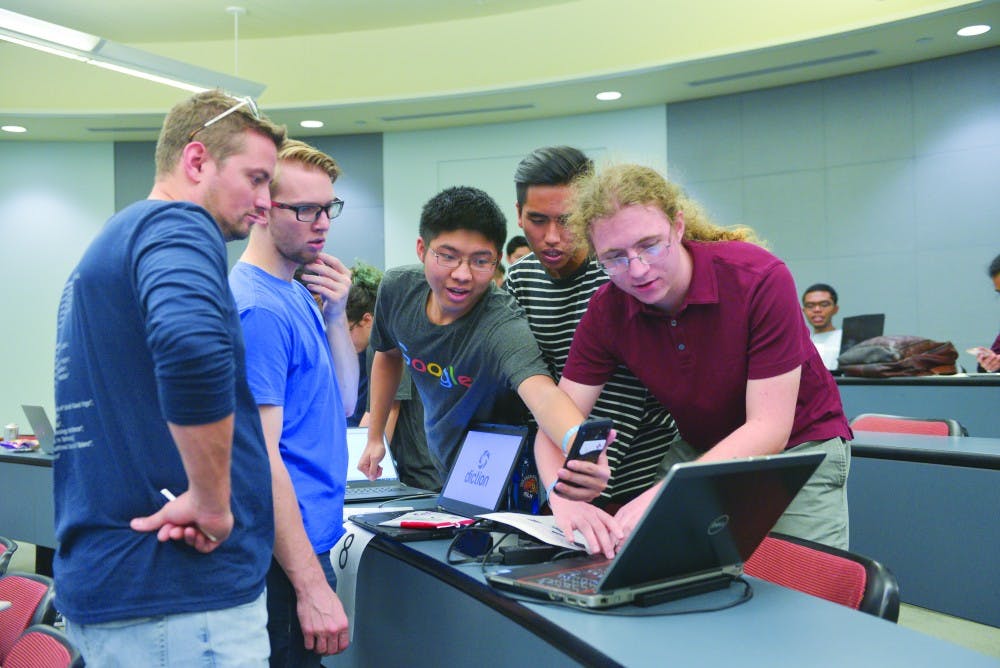More than 300 undergraduate and graduate students from across the country came together to participate in the biannual HopHacks event this past weekend on the Homewood Campus. HopHacks is organized Major League Hacking (MLH). It gives teams a limited 36 hours to develop an innovative model or app.
This year, HopHacks also challenged their participants to use a platform called “Lutèce” in the Civic Hack theme, sponsored by the Maryland Institute College of Art (MICA) and the Baltimore City IT Department (BCIT), with the goal of improving city life.
In an earlier interview with the Hopkins Department of Computer Science, Baltimore Mayor Catherine E. Pugh was excited to learn more about the innovative ideas the students would offer.
“Baltimore is a city of millennials and we’re fortunate to benefit from their energy, enthusiasm and innovative approach to identifying solutions that make city living better,” she said.
Pugh added that she looked forwarded to seeing what students created.
“Smart city government means depending on smart individuals who offer approaches that might not have been considered,” Pugh said. “I’m eager for the good ideas and insights that students here in our community will generate, and those from across the country.”
In addition to collaborating on a project to improve city life, HopHacks offers a wide variety of workshops and resources for their hackers. Workshops included an Introduction to Android Development, Building Mobile Apps with MongoDB Stitch and Google Cloud Platform Services, just to name a few.
After the three-day-long event, three projects emerged from the rest to claim the prize money and medals symbolizing their diligence and creativity.
Third place this semester went to iRelief. This app, inspired by devastating Hurricanes Harvey and Florence, aimed to offer the best method to deal with disasters in the community.
It cuts the three to five minutes spent sharing your location when calling 911 down to an instantaneous tap on your phone. It also offers a feature to speak to authorities and donate money to those in need.
Second place went to Charm City Murals. Their application showcases the various artistic scenes in Baltimore while revealing the rich past associated with each piece. It encourages Baltimore residents to explore the city and acknowledges public art as a voice of Charm City.
Dylan Madisetti, a graduate student in the Mechanical Engineering Department, shared his passion about the project in an email to The News-Letter.
“We built a ‘machine learning powered augmented reality web app’ for Baltimore’s murals. Behind all the buzz words, we made a killer experience for people walking the streets of Baltimore to learn what’s in front of them,” he wrote.
Furthermore, Jimmy Shi, a freshman majoring in Computer Science, spoke about the cutting-edge technology used in the making of the project.
“We used a mapping API, public data and image recognition software to allow users to identify, locate and learn about Baltimore murals,” he said.
Both Madisetti and Shi were inspired by their shared interests in Baltimore art as well as the public data on murals provided by HopHacks.
This project represented an integration between art and technology. However, the team had to overcome several obstacles during the hackathon to bring their inspiration to fruition.
“We encountered many roadblocks, such as adapting to each other’s workflow and putting together a finished product from many individual pieces. We were also challenged by the algorithms required for image detection and recognition. For me, I was completely new to front-end web development, so I had to learn how to create a clean website from the ground up,” Shi said.
Madisetti added that the competition’s long hours created extra stress.
“There was a point, 3 a.m. Sunday, where all the modules were written, but nothing was integrated. It was a little nerve racking when the first e2e test happened at like 5 a.m.,” Madisetti wrote.
First place went to PillUp. This team developed a pill-dispenser model in addition to an app that reminds patients to take their drugs. Combining with multiple platforms, the app can keep track of the remaining drugs left and record the most recent time when the patient took the drug.
Doctors can also be involved in setting the interval on how often the prescribed drug is dispensed. The team’s prototype was estimated to cost 50 dollars to produce, but the team stated that the cost can be reduced to around 20 to 30 dollars in the future.
Lastly, Madisetti and Shi have some advice for future new hackers.
“My advice would be to be proactive and join teams with people that you can learn from. The more technologies you pick up from Hackathons, the better equipped you will be for hacking!” Shi said.
“My undergrad was Mechanical Engineering, so I didn’t have the typical CS syllabus to develop my skills. It took a long time of practice and a lot of personal projects before I felt like I was an accomplished ‘hacker’,” Madisetti wrote.

















